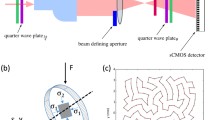Abstract
In displacement analysis of opaque bodies using holographic interferometry, it is a common practice to record one hologram of the body at some arbitrary load and then to increase the load and record a second hologram on the same photographic plate. The fringes in the reconstructed image correspond to the change in the displacement occurring between the two exposures. A new technique for photoelastic analysis based on this same idea will be presented. This technique, to be referred to as differential stress-holo-interferometry, has several advantages over existing techniques.
Using vector-algebra methods, the general intensity equations for a double-exposure hologram of a photoelastic model in which neither of the holograms is of the unstressed model is developed. In general the resulting interferogram is difficult to interpret; however, for selected types and levels of loading, a pattern which is easily interpreted results.
It is shown that the isochromatic fringes in these patterns are more precisely defined than those in a conventional double-exposed hologram of a photoelastic model. In addition, the new technique offers the advantages of increased fringe visibility, isochromatic-fringe multiplication, and an aid for the determination of the isochromatic-fringe order.
Finally, for certain types of models, a technique for producing an interferogram in which the isochromatics and isopachics are completely independent and the isopachics do not undergo a half-order-fringe shift is demonstrated.
Similar content being viewed by others
References
Rogers, G. L., “Polarization Effects in Holography,”J. Opt. Soc. Am.,56 (6),831 (June 1966).
Fourney, M. E., “Advances in Holographic Photoelasticity,”Applications of Holography in Mechanics, ASME, New York (1971).
Post, D., “Holography and Interferometry in Photoelasticity,”Experimental Mechanics,12 (3),113–123 (1972).
Sanford, R. J. and Durelli, A. J., “Interpretation of Fringes in Stress-Holo-Interferometry,” Catholic Univ. of America, Report to the Office of Naval Research No. 24, (AD 712869) (July 1970).
Sanford, R. J., “A General Theory of Polarization Holography and Its Application to Photoelastic Analysis,”Engineering Applications of Holography, Soc. of Photo-optical Inst. Eng., Redondo Beach, CA (1972).
Jones, R. C., “A New Calculus for the Treatment of Optical Systems, I. Description and Discussion of the Calculus,”J. Opt. Soc. Am.,31 (7),488–493 (July 1941).
Wiener, N., “Coherency Matrices and Quantum Theory,”MIT J. of Math. and Phys.,7,109–125 (1927–1928).
Jones, R. C., “A New Calculus for the Treatment of Optical Systems IV,”J. Opt. Soc. Am.,32 (8),486–493 (Aug. 1942).
Jones, R. C., “A New Calculus for the Treatment of Optical Systems V. A More General Formulation and Description of Another Calculus,”J. Opt. Soc. Am.,37 (2),107–110 (Feb. 1947).
Shurcliff, W. A., Polarized Light, Production and Use, Harvard Univ. Press, Cambridge, MA (1962).
Hovanesian, J. D., Brcic, V. andPowell, R. L., “A New Experimental Stress-Optic Method: Stress-Holo-Interferometry,”Experimental Mechanics,8 (8),362–368 (1968).
Fourney, M. E. andMate, K. V., “Further Applications of Holography to Photoelasticity,”Experimental Mechanics,10 (5),177–186 (1970).
Holloway, D. C. andJohnson, R. H., “Advancements in Holographic Photoelasticity,”Experimental Mechanics,11 (2),57–63 (1971).
Sanford, R. J. andDurelli, A. J., “Interpretation of Fringes in Stress-Holo-Interferometry,”Experimental Mechanics,11 (4),161–166 (1971).
Sciammarella, C. A. andQuintanilla, G., “Techniques for the Determination of Absolute Retardation in Photoelasticity,”Experimental Mechanics,12 (2),57–66 (1972).
Nisida, M. andSaito, H., “A New Interferometric Method of Two-dimensional Stress Analysis,”Experimental Mechanics,4 (12),366–376 (1964).
Howland, R. C. J., “On the Stress in the Neighborhood of a Circular Hole in a Strip Under Tension,”Phil. Trans., Series A,229,49–86 (1929).
Author information
Authors and Affiliations
Rights and permissions
About this article
Cite this article
Sanford, R.J. Differential stress-holo-interferometry. Experimental Mechanics 13, 330–338 (1973). https://doi.org/10.1007/BF02322392
Received:
Revised:
Issue Date:
DOI: https://doi.org/10.1007/BF02322392




